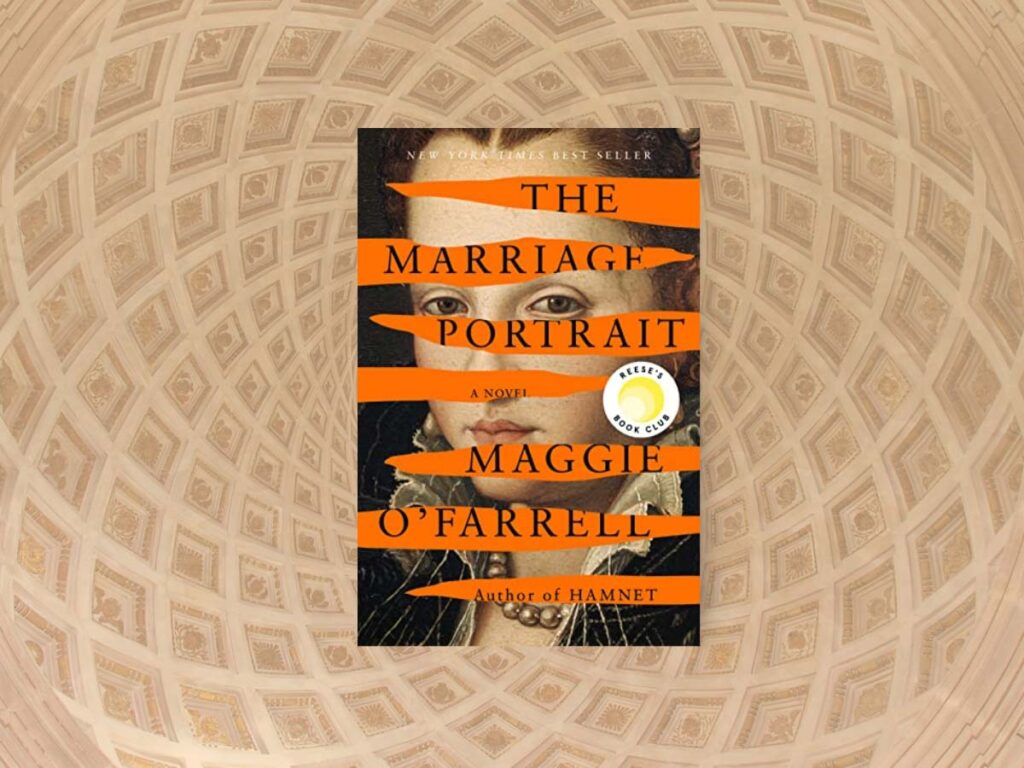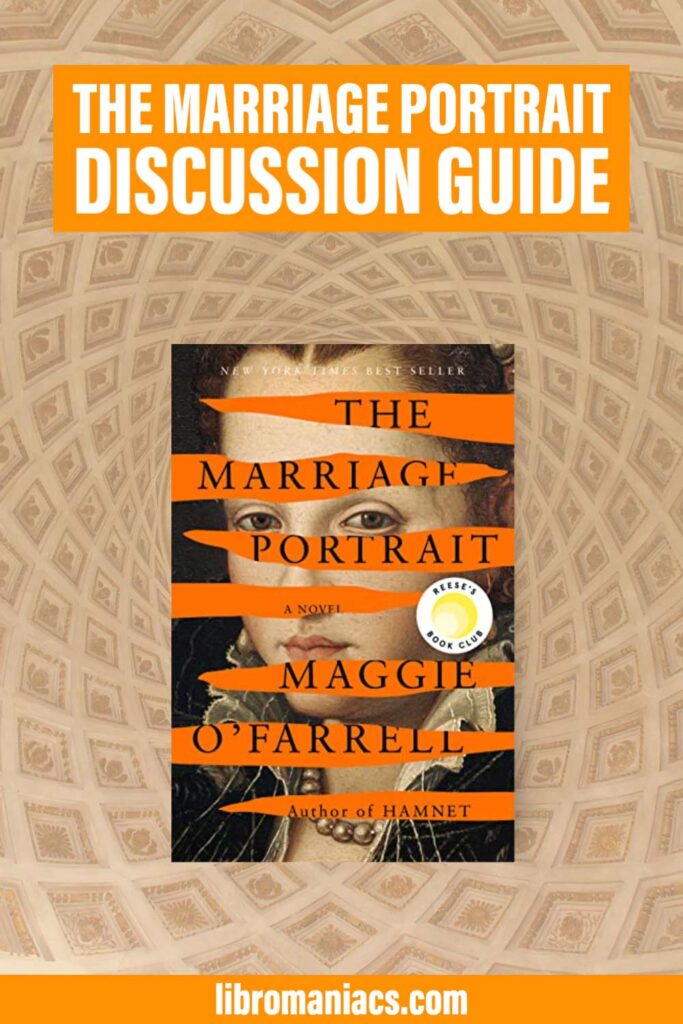We’re sure that reading The Marriage Portrait has immerse you and your book club in the Italian Renaissance during the 16th century. This book, focused on Lucrezia de Medici and the Duke of Ferrara, is a narrative framed around her impending death. The author also weaves the backstory of Lucrezia between two different timelines, in this fictionalized account of real-life people from Renaissance Italy. The key themes are duality and exchange. Switching between two variations of the same type permeates throughout the novel.
Be prepared for a vigorous conversation using our The Marriage Portrait book club questions. The discussion guide also features a book synopsis and some selected reviews. Plus, if you and your group enjoyed reading The Marriage Portrait there are some similar book suggestions provided future book club reads.

(This article contains affiliate links. This means that if you choose to purchase, I’ll make a small commission.)
The Marriage Portrait Synopsis
(We always chose to provide the publisher synopsis because we feel that it’s worthwhile to discuss whether the official book description actually squared with your experience of the book.)
The Marriage Portrait, Maggie O’Farrell
Florence, the 1550s. Lucrezia, third daughter of the grand duke, is comfortable with her obscure place in the palazzo: free to wonder at its treasures, observe its clandestine workings, and devote herself to her own artistic pursuits. But when her older sister dies on the eve of her wedding to the ruler of Ferrara, Modena and Reggio, Lucrezia is thrust unwittingly into the limelight: the duke is quick to request her hand in marriage, and her father just as quick to accept on her behalf.
Having barely left girlhood behind, Lucrezia must now enter an unfamiliar court whose customs are opaque and where her arrival is not universally welcomed. Perhaps most mystifying of all is her new husband himself, Alfonso. Is he the playful sophisticate he appeared to be before their wedding, the aesthete happiest in the company of artists and musicians, or the ruthless politician before whom even his formidable sisters seem to tremble?
As Lucrezia sits in constricting finery for a painting intended to preserve her image for centuries to come, one thing becomes worryingly clear. In the court’s eyes, she has one duty: to provide the heir who will shore up the future of the Ferranese dynasty. Until then, for all of her rank and nobility, the new duchess’s future hangs entirely in the balance.
Full of the beauty and emotion with which she illuminated the Shakespearean canvas of Hamnet, Maggie O’Farrell turns her talents to Renaissance Italy in an extraordinary portrait of a resilient young woman’s battle for her very survival.
The Marriage Portrait Book Club Questions
These questions have been tailored to this book’s specific reading experience, but if you want more ideas, we also have an article with 101 generic book club questions.
- “She felt the secret tigress move within her, like a bright ribbon weaving in and out of her ribs.”
What do you think the author is trying to convey about how Lucrezia lives her life with this simile?
- At a young age, Lucrezia’s temperament and emotional fits were difficult for her mother to bear. Do you think her personality and character traits are a liability or a benefit in shaping the course of her life?
- Alfonso’s closest male companion, Leonello, is loyal to him at all costs. Does Lucrezia have a similar loyal ally? If so, who? Does she have more than one ally?
- What distinctions did you notice between the way the Cosimo household raises their children and the way the Medici household raises their children?
- What is the symbolism of the portrait of Lucrezia? Why do you think Alfonso keeps it in his bedroom after he thinks he killed her?
- “Was there no hope? The tigress seemed to be asking her. Will I always remain here? Will I never return home?”
In what ways do Lucrezia and the tigress mirror each other? Is the tiger symbolic of Lucrezia?
- Death is a constant motif used in the story. What is the relationship between marriage and death in O’Farrell’s novel?
- Did your initial impressions of Elisabetta and Nunciata shift as the story progressed and you learned more about them? Could you handle being related to them, as their sister-in-law? Why or why not?
- What role does Emilia play in the narrative? In what ways does the author build her character development? In what ways does Emilia remain a stock character?
- To what extent does the author present a consistent picture of what life was like for women in Renaissance Italy in the 16th century? How does she account for the variations in women’s degree of freedom and mobility?
- How do you feel about the author reimagining Lucrezia’s fate, having her survive versus the tragic event of her death at the young age of 16?
Selected Reviews for The Marriage Portrait
(Use these selected Goodreads reviews to compare with your own experience of the book. Do you agree or disagree with the reviews?)
“Unfortunately, the literary magic I experienced and adored in Hamnet evaporated almost completely in The Marriage Portrait (2022). The latest novel by Maggie O’Farrell, which I awaited with wild excitement, is a historical ― or rather herstorical ― fiction with a feminist message delivered loud and clear, summarized in a short sentence: She has never had any choice. Maybe too loud and too clear but the problems described in the book are not gone. Nowadays, the motivation of murderers is not of a dynastic kind but nevertheless, it is not a closed chapter…”
“Skillfully written with sharp contrasts between the beautiful imagery created and the sad story of Lucz’s short life. I knew I had to be prepared for a sobering read because this brilliantly crafted story was drawn on real historical events. However, what made this special, apart from its authenticity, was the writing style that leaves you spellbound and sorrowful but also emotionally engaged.”
“Total lack of character development. […] I find it strikingly unfair to history to take the feminism of today and impose our views and attitudes on a teenage girl in the 16th century. It doesn’t respect who Lucrezia may have actually been. I would be less irritated if the main character were entirely fictional, rather than a fictionalized version of Lucrezia…”
“This was actually a really good story, with especially the last hundred pages being filled with intrigue and suspense. However there is just so much superfluous description; it’s like when in school you had to bulk up the word count in an essay so you just threw in a bunch of adjectives. I became quite adept at scanning through descriptions to reach plot points, however, that’s not the way I like to read a book…”
Books Like the The Marriage Portrait
If you liked reading Maggie O’Farrell, we’ve also got a book club guide for Hamnet, which is an alternative imagining of Shakaspeare’s home life and his mercurial wife.
You can also peruse our historical fiction tag which also has book club guides for The Book of Longings, Pachinko, and Matrix.
This book was also a Reese’s pick and if you like her recommendations, we’ve also got guides for Honor, Next Year in Havana, The Library Book, House in the Pines and The Christie Affair (which is also a fictionalized account of a real historical person).

The Queen’s Vow: A Novel of Isabella of Castile, C.W. Gortner
Barely a teen, Isabella is thrusted into affairs of state, and used as a pawn to dethrone her half-brother King Enrique. After the death of both her brothers, she becomes the unlikely heir to inherit the throne of Castile.
Suspected of treason and held captive, she treads a perilous path, torn between loyalties, until at age seventeen she suddenly finds herself heiress of Castile. She goes on to marry a prince of Spain and from there the two build an empire.
If the Spanish setting sounds interesting to you, we also have a whole list of books set in Spain.

The Birth Of Venus: A Novel, Sarah Dunant
This novel is about an aspiring female painter named Alessandra Cecchi, who becomes drawn to a professional painter hired to work at her family’s palazzo. However, her father marries her away to a much older, wealthy man.
The book covers her story (as told by her late in life), but it also explores a lot of the shenanigans of the wealthy Medici family, and the religious extremism of the monk Savanarola.

The Botticelli Secret, Marina Fiorato
This book is billed as a cross between The Da Vinci Code and The Birth of Venus, and is also set in Renaissance Italy.
This story is centered around a young woman named Luciana, who is a model and whore in 15th-century Italy. Luciana must flee for her life after stumbling upon a deadly secret when she serves as a model for the famous artist, Botticelli.
In fact, Fiorato has a whole slew of books in Italian settings featuring female protagonists, including for Murano, Sienna, San Marco, and Venice.
Have a listen on Audible. Try audio books for free for 30 days.
Share The Marriage Portrait book club questions with your friends:

